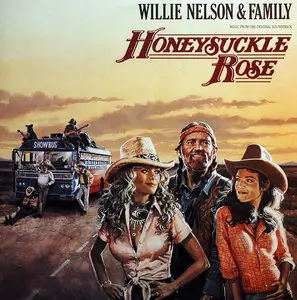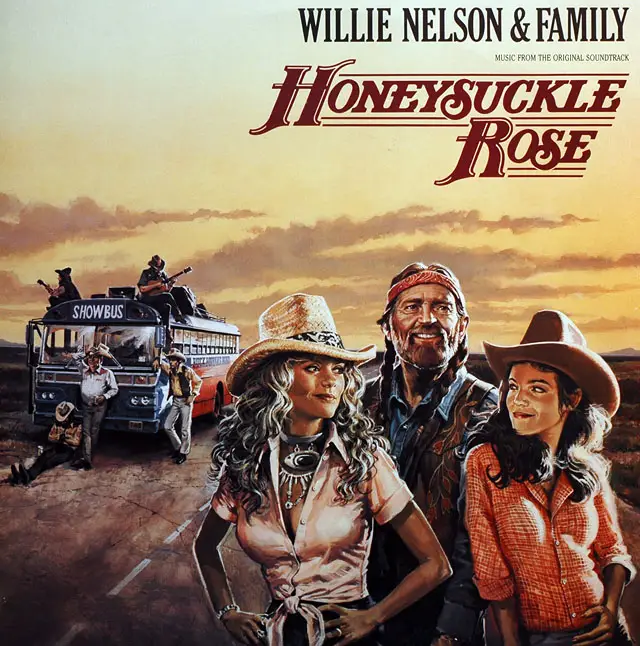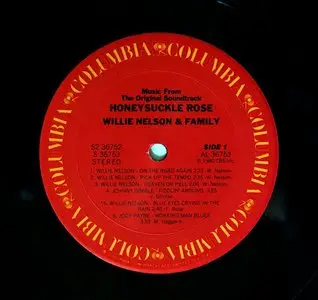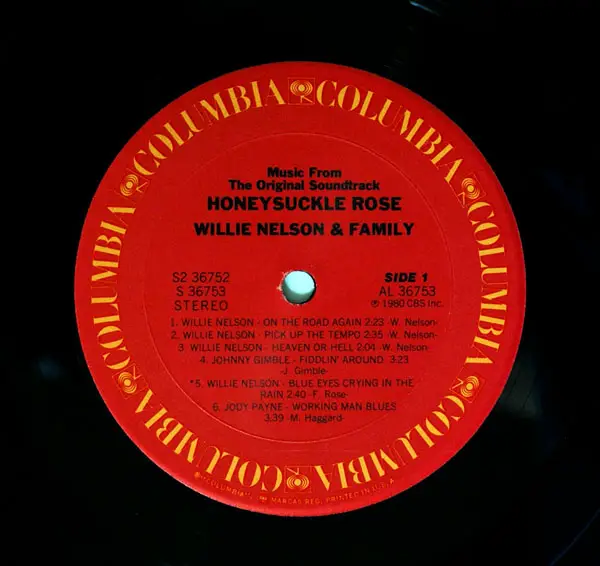Willie Nelson - Honeysuckle Rose
Vinyl Rip in 24-Bit/96-kHz | FLAC tracks | no cue | no log | Covers | MU, FS | 1.44 GB 3% recovery
1980 | Genre: Country | Label: CBS | 36752 | Double LP, US pressing
Rated 4 out of 5 star by AllMusic Guide
Nelson rode the success of The Outlaws to make his beautiful collection of standards, Stardust, which Nelson says moved his tough friend Jennings to tears and, like a handful of popular recording artists of the time, he was propelled to the big screen. He was tapped to make Honeysuckle Rose, a movie that's part fiction, part concert film. Many of the songs to be used in the movie were already well-known, such as “Blue Eyes Crying in the Rain” and “Whiskey River,” but the filmmakers wanted Nelson to come up with a new song about touring to be the signature track.
“I was on a plane with Sydney Pollack and Jerry Schatzberg shortly after I signed to do the movie Honeysuckle Rose,” Nelson recalled in Willie. “Sydney was the executive producer and Jerry the director, and they were talking to me about the music. They wanted a song. ‘What kind of song?’ I said. Either Sydney or Jerry said, ‘Well, some kind of song about people traveling all over the country making music.’ I said, ‘You mean being on the road again?’ They said, ‘Yeah, that's it!’ I like to show off occasionally. I picked up an envelope, or maybe it was an airsick bag, and wrote:
“On the road again.
I just can't wait to get on the road again.
The life I love is making music with my friends.
I just can't wait to get on the road again.
“‘How about this?’ I said.”
For much of the picture, live shows by Willie Nelson and his Family Band were recorded before audiences filled with lucky fans who had won the chance to be “extras” in radio giveaways. They were real concerts, with real audiences, filmed to be part of a road movie about a fictional artist.
The recording engineer for the movie music and the soundtrack album was Bradley Hartman, who had been with Brian Ahern's Enactron Studios for a few years. He had recorded and mixed Stardust, as well as other Nelson projects during the mid-1970s. “I wasn't in the union, and movies always have to be full-union, so they always had to have union people hired to be there, but I was actually working the controls,” recalls Hartman, who also notes that the songs for Honeysuckle Rose were captured the way he'd record a live concert album: “Showco was doing the live sound, and we interfaced and did a split off their audio.”
Hartman recorded to a Stephens 24-track tape machine, using the Enactron truck's Neve console. “It was one of the older, big Neve split consoles with the inputs on one side and the monitor section on the other,” he says. “It was all recorded 24-track with SMPTE sync to the film.”
Hartman says Nelson sang into a Shure SM58 microphone, and he remembers using some additional drum mics beyond what Showco had set up. “I used some 451s for overheads,” he says. “At that time, it was a crazy band that Willie had. There were two drummers — one playing stick and the other playing brushes on top of it — and two bass players. There were two guitar players and Willie and Mickey Raphael playing harmonica. It was basically Willie's longtime band, plus a few extras.”
The signature song, “On the Road Again,” was recorded about a dozen times, in various venues and in front of different audiences, until Nelson, who was the producer of the tracks, and Hartman knew they had “the take.”
“We took the truck to Austin and San Antonio, and all around the Texas hill country on different locations to do the movie,” Hartman says. “There were a couple of clubs in Austin. We did the Hemisphere Arena in San Antonio. They found an old Texas-style dance hall out in the country in Fisher, Texas, where we did several days of shooting. But the one that ended up being on the album and the single was one that was recorded at a club in Austin called Soap Creek Saloon. I don't believe it's there anymore, but we worked there for two days. We set up and they brought in extras; it was like a free show. We recorded ‘On the Road Again’ two or three times there, and one take was just magical.”
Four months after the movie shooting was complete, Hartman took the tracks to New York City to help with post work. “I was involved in post-production on the movie because quite a few of the music performances are interspersed with dialog and action,” he says. Later, the project moved to L.A., where post was completed at Todd-AO Sound and Hartman mixed the album and single in Wally Heider's Studio 4. “They'd just put in a new Neve 8108 console and a new Ampex machine there,” Hartman recalls. “They were calling it the ‘Studio of the Decade’ at that point.” He monitored on the studio's UREI 813 mains and A/B'd with Yamaha NS-10 near-fields.
Going back and listening to the recordings they'd made on location confirmed Hartman's opinion of which take of “On the Road” was the keeper. “It was just the energy that came off the stage,” he says. “This take of it just jumped out. I mixed it a couple of times and made sure the audience response was where it should have been; there were 451s, audience mics in the club, and I blended those to get the energy of the audience, but the performance is totally live.”
Shortly after the Honeysuckle Rose movie was released, Hartman left Nelson's camp and became an independent engineer. “I did a few more things with Willie; I remixed a couple of singles for him, but that was pretty much the last thing I did. Pretty soon thereafter, he built his own studio [Pedernales] and moved all his stuff there.”
Hartman went on to record albums for Rodney Crowell and Rosanne Cash. His career later included a very settled period in the early 1980s, when he lived in L.A. with his wife and child, recording voices for a toy company called Alchemy II. “I recorded every word Teddy Ruxpin ever said,” Hartman says with a laugh. In the late 1980s, he moved to Nashville, where he now runs his own studio, Trace Sound, and records mainly acoustic singer/songwriters and bluegrass artists such as Tim O'Brien.
Nelson, of course, continued building a much-celebrated career on his own terms. He won a Best Country Song Grammy in 1980 for “On the Road Again,” which continues to be not only one of his trademark tunes, but also his way of life. “When I walk off the stage after a hot show,” Nelson wrote, “I'm so wired on a natural high that for the next two or three hours, my feet barely touch the floor. It used to be, when the regular show was over and everybody was roaring, we'd go to a bar or somebody's house and the band would keep playing until we could see the sunlight through the windows and hear the birds singing outside. Now we get into our caravan of buses and leave town as soon as the show is over. There's plenty of time to come down when you're rolling all night on the highway.”
(Barbara Schultz - Mix Magazine, 2006)
Track Listing:
A1. On the Road Again
A2. Pick Up the Tempo
A3. Heaven or Hell
A4. Fiddlin' Around
A5. Blue Eyes Crying in the Rain
A6. Working Man Blues
B1. Jumpin' Cotton Eyed Joe
B2. Whiskey River
B3. Bloody Mary Morning
B4. Loving You Was Easier
B5. I Don't Want to Do Windows
B6. Coming Back to Texas
C1. If You Want Me to Love I Will
C2. It's Not Supposed to Be ThatWay
C3. You Show Me Yours
C4. If You Could Touch Her at All
C5. Angel Flying Too Close to the Ground
C6. I Guess I've Never Come
D1. Angel Eyes
D2. So You Think Your a Cowboy
D3. Make the World Go Away
D4. Two Sides to Every Story
D5. A Song for You
D6. Uncloudy Day
Turntable: Roksan Radius III
Tonearm: Audioquest PT-9
Cartridge: Ortofon X5-MC (Moving Coil)
Phono Cable: Van den Hul D-502 Hybrid
Pre-amplifier: Counterpoint SA 5.1 (vacuum tube Sovtek 6922)
Interconnect: balanced, Belden 1813A cable with Neutrik XLR connectors
Analog to Digital Converter: EMU 1212M (configured for balanced input +4dBu, 0 dB Gain)
Capture software: Goldwave 5.52
Post processing: ClickRepair, setting: 15, reverse, wavelet x3
Tonearm: Audioquest PT-9
Cartridge: Ortofon X5-MC (Moving Coil)
Phono Cable: Van den Hul D-502 Hybrid
Pre-amplifier: Counterpoint SA 5.1 (vacuum tube Sovtek 6922)
Interconnect: balanced, Belden 1813A cable with Neutrik XLR connectors
Analog to Digital Converter: EMU 1212M (configured for balanced input +4dBu, 0 dB Gain)
Capture software: Goldwave 5.52
Post processing: ClickRepair, setting: 15, reverse, wavelet x3





